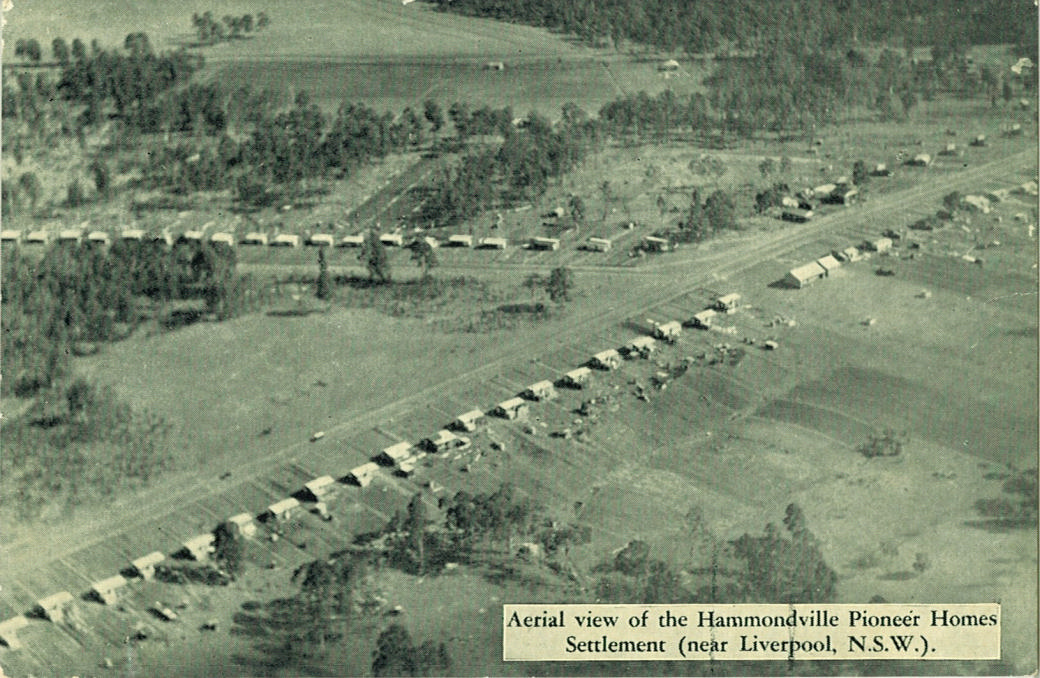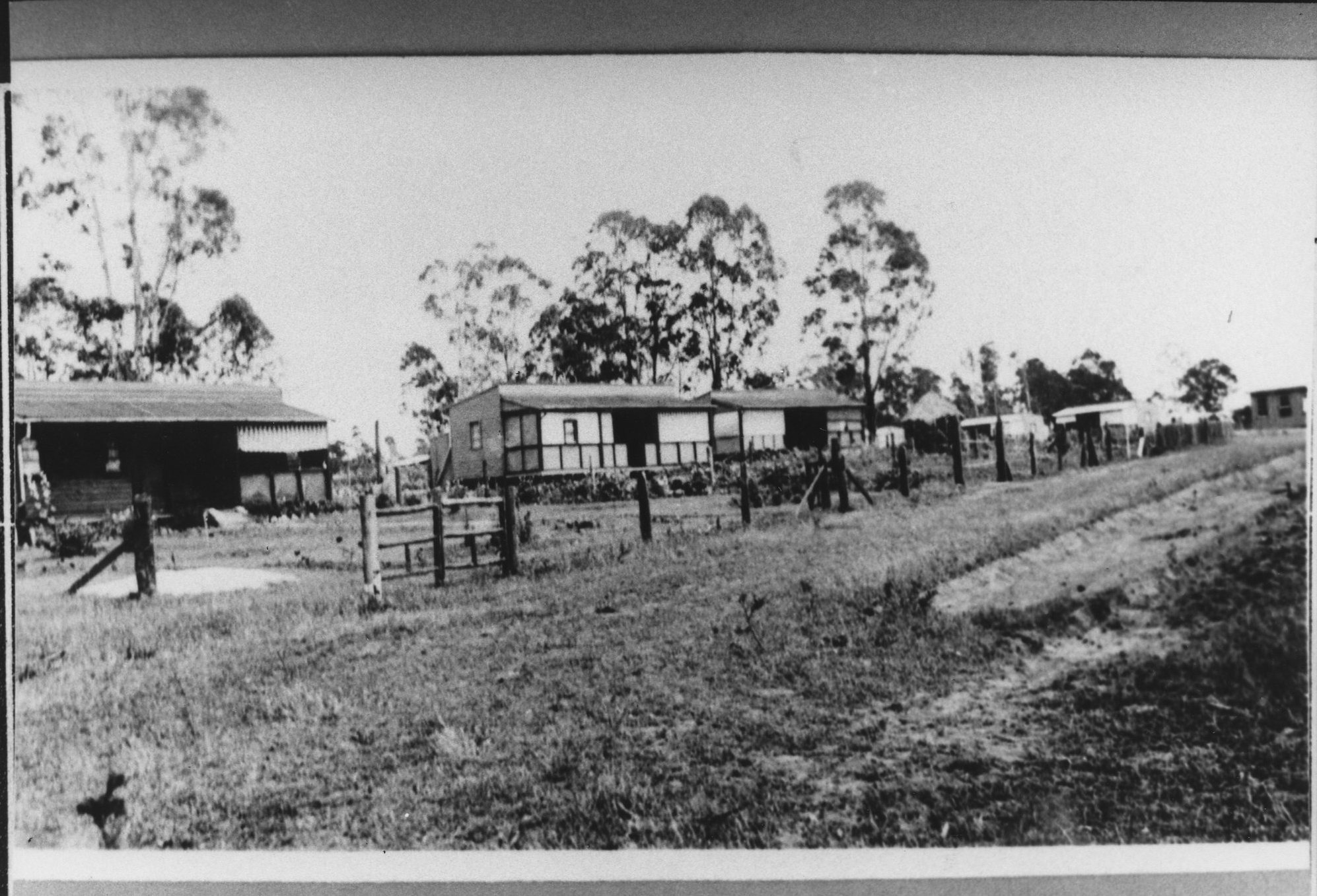Hammondville was officially gazetted on 7 April 1972. Hammondville is named for Anglican Archdeacon Canon Robert Brodribb Stewart Hammond (1870-1946).
Colonial Land Grants
The area of Hammondville made up the land grant of 700 acres given to Thomas Rowley, son of Captain Thomas Rowley. Thomas Rowley was born in 1794 in the colony of New South Wales. In 1828 Rowley, wife Catherine and five children were established in Holsworthy.
Hammond’s Pioneer Homes
During the Depression of the 1930s, many Sydney families were suffering the hardships of unemployment, eviction and an uncertain future. One third of the Sydney labour market was unemployed.
R.B.S. Hammond was a charismatic, philanthropic social activist. He established a non-profit called Hammond’s Pioneer Homes (now known as HammondCare) at Hammondville. Thirteen acres of uncleared land were selected between Illawarra Road (currently Heathcote Road) and the Tucoreah-Georges River, and the first self-contained rural cottages opened on 20 November of 1932. 110 homes were built under the scheme between 1932 and 1938. In what was regarded as one of the most successful housing initiatives of its type.

Aerial view of the Hammondville Pioneer Homes Settlement, circa 1936
The organisation was advertised as “Not a charity, but an opportunity”. As an experimental ‘back to the land’ housing scheme, each family was granted a cottage on one acre of land and part of the land had to be used to grow food. For a quick 15-day build, the original cottages were simple timber weatherboard designs with two bedrooms, a shower and a small kitchen. Later, chimneys were added along the shallow verandas, and baths and stoves were put inside.
To obtain a house in Hammondville, a family had to have a marriage certificate, at least three children, the parents had to be unemployed and the family had to have been evicted or facing eviction.
Allotments were offered on a ‘rent-purchase’ basis. Neither a deposit nor interest were charged. The allotments cost 25 pounds and the cottages were valued at 75 pounds. It was expected that residents would take seven years to complete their payments.
“Back to the land might not mean lots of money, but it meant health, home-ownership and independence. The State was in a condition of shipwreck, and the people must take advantage of every spar to save themselves” - 10 February 1932, Sydney Morning Herald
Prior to World War II, home ownership had been associated with middle-class prosperity. However, the invention of fibro (asbestos cement) made homeownership possible for working-class families and worked to turn people away from the centralisation of the urban slum. Arguably, Hammondville’s Pioneer settlement was more successful than other post-war ‘back to the land’ programs established by the Federal Government under Soldier Settlement Schemes, such as those in Hillview and Chipping Norton.

Hammondville Pioneer Homes Settlement, circa 1935
Hammond’s Social Services and his Pioneer Village combined the moralising facets of Anglican evangelism, temperance activism, and a concern for racial and social degeneration. ‘Back to the Land’ was a program designed on the principles of hereditary and environmental determinism and buttressed by the White Australia Policy. Hammondville was a protectionist, idealistic venture, designed to provide an ‘ideal’ environment for raising healthy future citizens. However, the settlement was plagued with public health concerns. Sewerage remained a point of contention with the Liverpool Municipal Council until the 1970s.
In the 1950s aged care provisions were added to Hammondville and a nursing home was built in 1945. In 1989 an Aged Day Care Centre was officially opened and the Meadows Dementia Care Hostel was completed in 1995.
Plane Crash
On the 8th of June 1942, Bankstown Airfield received a phone call saying that Sydney was being shelled by an Imperial Japanese submarine. Lt George Leo Cantello (0-388884) of the 41st Fighter Squadron, 35th Fighter Group took off immediately in his P-400 Airacobra aircraft. The aircraft's engine failed about two minutes after take-off, and it crashed to the ground north of Hammondville. In 1988, as a Bicentennial project, the citizens of Bankstown unveiled a memorial in memory of 1st Lt Cantello, located on Stewart Ave, Hammondville.
In 1991, Hammondville resident Mary Schofield recalled the night the airplane crashed.
Interviewer: Were you here when the Americans were out here?
Mary Schofield: Only this airplane that crashed down here. That particular night I can always remember that. We thought it was the Japanese coming to Sydney Harbour – which they did do, cause our little dogs were going mad. We had two little fox terrier dogs. The little female – little Trixie, she used to yam, yam, yam, you know, like a human being, and we wondered what was the matter. And then the other dog started howling, and not long after that the siren went off up at the shop. We had a siren. We used to keep our windows blackened out of a night, you know, we used to put the stuff in the windows to keep the light out and we had a chap coming round in the night singing ‘put that light out’…..Anyway, this particular night when the dogs were howling and the siren went off, we knew something was wrong….Not long after the siren went off this plane took off from Bankstown Airport and it just flew in a circle. We were standing on our open veranda watching. The plane came over real slow, came right over the top….and I’m sure it hit one of the trees near where the laundry is down there now…And the explosion simply terrific – just a ball of black and red smoke from it, flames and smoke….
Interviewer: And he got killed too, I suppose?
Mary Schofield: Oh, blown to smithereens! There was nothing of him, nothing left at all.
The complete oral history interview, conducted as part of Moorebank Women’s Oral History Project (1991), can be listened to on Liverpool City Library’s catalogue.
Burke, Colleen et. al.. The heart of a place : stories from the Moorebank Women's Oral History Project : covering the suburbs of Moorebank, Chipping Norton, Hammondville and Holsworthy in the Liverpool City Council area (Liverpool: Liverpool City Council), 1992. Catalogue Access: https://liverpool.spydus.com/cgi-bin/spydus.exe/ENQ/WPAC/BIBENQ?SETLVL=&BRN=139704
Judd, Bernard G., “Sunsets into Sunrises”: Commemorating the 60th Anniversary of the beginning of Hammondville, (Liverpool: Self-published), 1992. Copy available at the Family History Centre, Liverpool Regional Museum, Liverpool, NSW, 2170
Zilber, Gabrielle and Liverpool Regional Museum. Hammondville: Liverpool Regional Museum, 7 April – 27 May 2000 [pamphlet] (Liverpool: Liverpool Regional Museum), 2000.
Hammondville Funds. 12 Charming Views Of The Famous Hammondville Pioneer Homes Settlement [postcards] (Liverpool: Hammondville Funds), 1936. Catalogue record: https://liverpool.spydus.com/cgi-bin/spydus.exe/ENQ/WPAC/ARCENQ?SETLVL=&RNI=238043
Hammondville (Hammond's Pioneer Homes): founded by the late Archdeacon R.B.S. Hammond, O.B.E: An adventure in practical Christianity (Sydney : Gowans & Giltrow), 1952
’Back to the Land – Canon Hammond’s Appeal’, Sydney Morning Herald, 10 February 1932
Kass, Terry. Heritage Assessment of the Hammond Village (formerly the Hammondville Homes for Senior Citizens), for the Hammond Care Group, March 1996.
Hammond Care - https://www.hammond.com.au/about/history
Dictionary of Sydney : Hammondville, https://dictionaryofsydney.org/entry/hammond_robert_brodribb_stewart
TROVE - GEOGRAPHICAL NAMES ACT, 1966 (1972, April 7). Government Gazette of the State of New South Wales (Sydney, NSW : 1901 - 2001), p. 1199. Retrieved May 25, 2021, from http://nla.gov.au/nla.news-article220139777
Moorebank Women Writer’s Group (1991). Oral History Audio Recordings [digitised audio files and original cassete tapes] Moorebank Women's Oral History Project, 1991. LH00010_02/1-26. Catalogue record:
https://liverpool.spydus.com/cgi-bin/spydus.exe/ENQ/WPAC/ARCENQ?SETLVL=&RNI=620926
“About the Profile Areas | Hammondville | Profile.Id.” https://profile.id.com.au/liverpool/about?WebID=210 (Accessed 03/03/2022)
Christopher Keating. On the Frontier: A Social History of Liverpool (Sydney: Hale & Iremonger, 1996), pp.160-170.
”CRASH OF AN AIRACOBRA AT HAMMONDVILLE, NSW ABOUT 3 MILES SSW OF BANKSTOWN AIRFIELD ON 8 JUNE 1942”. Accessed 28/02/2022. Source: https://www.ozatwar.com/nsw25.htm
Mary Schofield interviewed by Daphne Gawke, 5 May 1991. Moorebank Women’s Oral History Project (Liverpool: Moorebank Women Writer’s Group, 1991).
See something missing?
You know your suburb better than anyone. If you think an important part of your suburb’s history is missing, whether recent or distant, reach out to the Local Studies Team through our online Local and Family History enquiry form. We are always looking for new ways to bring the vibrant history of Liverpool to life!
